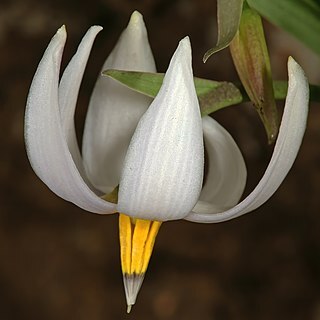Leaves cauline, becoming progressively larger and congested towards the stem apex, sessile, (2)7-17 × 0.2-1 cm, linear to linear-lanceolate, acute or ± gradually tapering to the apex, occasionally slightly cirrose at the tip, with recurved prickles 0.75–c. 1 mm long on the midvein beneath and/or on the leaf margin, or prickles absent; lowermost leaves 0.7-1.2 cm long, membranous.
Perennial herb, up to 0.6 m high. Leaves sessile, linear to ovate, sometimes scabrid or armed with prickles. Flowers solitary. Perianth segments 6, forming a short tube, spreading. Stamens attached to perianth segments at throat of tube; anthers yellow with blue or purple tips. Flowers pink, mauve or pale blue.
A herb with a corm or bulb. It grows 30 cm high. There are 1-5 tubers and they are 2-3 cm across. They occur up to 20 cm below the ground. The leaves occur along the stem. They become larger and closer together up the stem. They are narrow and 7-17 cm long by 1 cm wide.
Stem leafy, simple or sometimes with up to 3 branches from axils of the lower leaves, ± flexuous, ± strongly longitudinally ribbed at least above, glabrous, scabrid, or with scattered short recurved prickles.
Tepals pure white to pink, mauve, purple or blue, spreading, 6-15 × 2-5 mm, ovate, acute, 5-7-veined, free to the base, ± recurved at the tips, outer segments slightly longer than the inner.
Anthers 4-8 × 0.75 mm, yellow with blue to purple tips, connivent and adherent at the apex; pores lateral at the anther apex, introrse, oblique.
Capsule green, yellow or orange,8-17 mm in diameter, globose, slightly rugose, surrounded by the persistent perianth segments.
Peduncles 2-5 cm long, ascending, smooth, scabrid or with minute prickles; bracts 5-17 × 0.5-2.5 mm; pedicels deflexed.
Tubers 1–5, subspherical, 1.7-2.5 × 2-3 cm, up to c. 20 cm below ground on a slender vertical underground stem.
Style 7-8.5 mm long, shorter than, or slightly exserted from the perianth segments.
Erect perennial herb (4)10–30 cm tall.
Filaments 0.5-1 mm long.
Immature seeds 2 × 1 mm.

